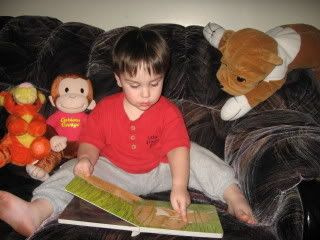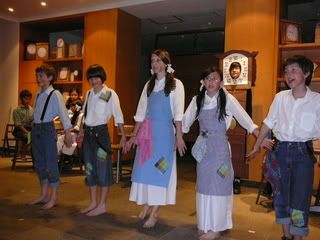I introduced this unit to the children by first pointing to ears and hearing as a gift from God. I asked them to tell me what they were thankful to be able to hear. Birds, Mama & Daddy, friends, music, stories, movies, and on and on they went with the list. “We must use our ears as well as our lives to glorify God. Now, what is the chief end of man?”
Nathan5 and Lane7 quickly answered, “Man’s chief end is to glorify God and enjoy him forever.” (We have been working on The Westminster Shorter Catechism and they have learned the answer to question #1 without hesitation.)
In order for them to learn a little bit about the way the ear works, I asked them to trace a simple drawing of the ear's anatomy and then label the outer ear, the eardrum, the hammer, anvil, & stirrup, the cochlea, and the Eustachian tube. For Nathan5, I wrote the words and he glued them to his drawing and drew lines from each word to the correct part of the ear.

Two games were played. First, I blindfolded the boys and asked them to identify sounds like tapping with a pencil, shutting a door, hanging up the phone, or anything else I could think of. They were both quite good at guessing correctly and were enjoying their success. Then I asked them to point in the direction the sound was coming from. They were usually correct. In the second game (or experiment), they remained blindfolded, but they also plugged one ear with cotton. Our plan was to test whether two ears are better than one. I kept moving around the room to make the sounds. This time when I would clap or ring a bell, they had a much harder time getting the direction right. Through this activity, they could readily see that two ears working together are needed to help us know the direction a sound comes from.
The highlight of this day was setting up a giant ear for them to crawl through. We attached an old sheet between two chairs to serve as the outer ear. We cut a hole in it just big enough for them to crawl through. Then we made a tunnel of blankets to serve as the ear canal. We placed a toy drum at the end of the tunnel and touching it was a hammer, and two tools representing the anvil and the stirrup. We couldn’t come up with a good symbol for the cochlea, so I just drew a large picture of it. An extension cord went from the cochlea (drawing) to the brain (which was imaginary). We just used what we had, but the boys loved it. It gave them first hand, touching experience with the parts of the ear. Robert2 loved popping through the sheet hole and crawling under the blankets to the inner ear parts.

I started reading aloud a book titled Helen Keller’s Teacher.
We really liked this book. It told the story of Helen Keller from the point of view of Helen's remarkable teacher, Annie Sullivan. The author reveals the character of Annie Sullivan through her childhood background, her difficult circumstances, and her blindness. The reader appreciates her discipline, determination and tenacity as she applies her skills to the spoiled hard case, Helen Keller. This book was easy for my 5 and 7 year olds to understand.
Proverbs 4:20 My son, pay attention to what I say, listen closely to my words.











